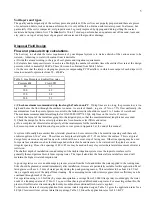
9
Table 4. Subsurface drip installation methods.
INSERTION
METHOD
ADVANTAGES DISADVANTAGES
a) Hand Trenching*
•Handles severe slopes and confined areas
•Uniform depth
•Slow
•Labor intensive
Disrupts existing turf and ground
•Back fill required.
b) Oscillating or Vibrating
plow -
of the cable or pipe pulling
type.
• Fast in small to medium installations.
•Minimal ground disturbance
•No need to back fill the trench.
•Depth has to be monitored closely.
•Cannot be used on steeper slopes(20% )
•Requires practice to set and operate
adequately.
•Tends to "stretch" pipe. Shorter runs are
required.
c) Trenching machine.
Ground Hog, Kwik-Trench,
E-Z Trench*
•Faster than hand trenching
•May use the 1" blade for most
installations
•Uniform depth
•Slower, requires labor.
•Disrupts surface of existing turf.
•Back fill required.
d) Tractor with GEOFLOW
tubing insertion tool - see
diagram 3.
Preferred method.
•Fast.
•Little damage to existing turf.
because of the turf knife.
•Minimal ground disturbance.
•Does not stretch drip line.
•Adaptable to any tractor.
• The installation tool is designed
specifically for this purpose and is only
available from GEOFLOW.
e)Tractor mounted 3-point
hitch insertion implement
•Fastest. Up to four plow attachments with
reels.
•A packer roller dumps back soil on top of
the pipe.
•Suitable for large installations only.
* NOTE: Disturbing the soil may effect the pore structure of the soil and create hydraulic conductivity problems. Please
consult with your soil scientist or professional engineer before making the installation technique decision.
The State of Georgia specifically does not accept the practice of using a conventional back-hoe.
6. SYSTEM MAINTENANCE
Monitor the system
The best way to assure years of trouble free life from your system is to continuously monitor the system and to automate all
maintenance functions. For large systems or systems with a BOD > 20 mg/l automation of maintenance is essential. For
smaller systems with a BOD < 20 mg/l quarterly inspections and maintenance is adequate.
• Frequent automatic filter flushing based upon pressure drop across the filter is essential for the correct operation of the
system. Filters should be cleaned when the pressure difference reaches 50 kPa. If the filter clogs frequently, a larger filter
may be required.
• Flush the system under pressure. The velocity in the pipes should be as high as possible to transport the deposits and
scale. Use the pressure regulator bypass or kick-in both pumps if two pumps are used. This should be done at least every
40 cycles of the disposal fields.
• Inject a commercially available cleansing solution with fresh water through the system. Chlorine and either phosphoric
or sulfuric acid at low concentrations are suitable. This should be done automatically in the event of the flow rate dropping
more than 5% below specified standard flow rate.
• Clean the pressure reducing valves and check that they are working well. Check system pressures.
• Clean flush valves and vacuum release valves.






























